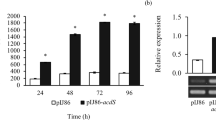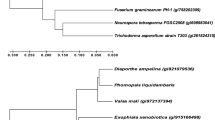Abstract
Soil salinity is one of the major plant growth and yield-limiting constraints in arid and semi-arid regions of the world. In addition to the oxidative damage, increasing salt stress is associated with elevated cellular ethylene levels due to the synthesis of 1-aminocyclopropane-1-carboxylic acid (ACC) in large amounts. The objective of the current study was to elucidate the inoculation effect of an ACC deaminase (ACCD)–producing phytobeneficial strain Achromobacter sp. FB-14 on rice plants to alleviate the salinity effects by upregulation of the stress-responsive CIPK genes. The strain FB-14 was isolated by using nutrient agar medium at 855 mM NaCl concentration and it was taxonomically identified as Achromobacter sp. with more than 99% 16S rRNA gene sequence similarity with many Achromobacter species. The strain FB-14 demonstrated substantial in vitro potential for ACCD activity, synthesis of indole compounds, and phosphate solubilization up to 100 mM NaCl concentration in the culture medium. The gene corresponding to ACCD activity (acdS) was amplified and sequenced in order to confirm the inherent enzyme activity of the strain at a molecular level. The rifampicin-resistant derivative of strain FB-14 was recovered from the rice rhizosphere on antibiotic medium up to 21 days of sowing. Moreover, the strain FB-14 was inoculated on rice plants under salinity and it not only enhanced the growth of rice plants in terms of root and shoot length, and fresh and dry weight, but also upregulated the expression of stress-responsive CIPK genes (OsCIPK03, OsCIPK12, and OsCIPK15) according to the results of qRT-PCR analysis. To the best of our knowledge, this is the first report deciphering the role of plant-beneficial Achromobacter strain relieving the rice plants from salt stress by promoting the growth and enhancing the expression of stress-responsive CIPK genes.





Similar content being viewed by others
References
Birla DS, Malik K, Sainger M, Chaudhary D, Jaiwal R, Jaiwal PK (2017) Progress and challenges in improving the nutritional quality of rice (Oryza sativa L.). Crit Rev Food Sci Nutr 57(11):2455–2481
Sarkar A, Pramanik K, Mitra S, Soren T, Maiti TK (2018) Enhancement of growth and salt tolerance of rice seedlings by ACC deaminase-producing Burkholderia sp. MTCC 12259. J Plant Physiol 231:434–442
Chen CY, Mei HC, Cheng CY, Lin JH, Chung YC (2012) Enhancing the conversion of organic waste into biofertilizer with thermophilic bacteria. Environ Eng Sci 29(7):726–730
Zafar S, Ashraf MY, Anwar S, Ali Q, Noman A (2016) Yield enhancement in wheat by soil and foliar fertilization of K and Zn under saline environment. Soil Environ 35(1):46–55
Heydarian Z, Yu M, Gruber M, Glick BR, Zhou R, Hegedus DD (2016) Inoculation of soil with plant growth promoting bacteria producing 1-aminocyclopropane-1-carboxylate deaminase or expression of the corresponding acdS gene in transgenic plants increases salinity tolerance in Camelina sativa. Front Microbiol 7:1966
Barker R, Herdt RW, Rose B (1987) The rice economy of Asia. Johns Hopkins University Press, Washington, DC, pp 224
Cheeseman J (2016) Food security in the face of salinity, drought, climate change, and population growth. In: Khan MA, Ozturk M (ed) Halophytes for food security in dry lands. Academic Press, Amazon Digital Services LLC, Cambridge, pp 111–123
Radanielson A, Gaydon D, Li T, Angeles O, Roth C (2018) Modeling salinity effect on rice growth and grain yield with ORYZA v3 and APSIM-Oryza. Eur J Agron 100:44–55
Xiang Y, Huang Y, Xiong L (2007) Characterization of stress-responsive CIPK genes in rice for stress tolerance improvement. Plant Physiol 144(3):1416–1428
Chen X, Gu Z, Liu F, Ma B, Zhang H (2010) Molecular analysis of rice CIPKs involved in biotic and abiotic stress responses. Chinese J Rice Sci 24(6):567–574
Kanwar P, Sanyal SK, Tokas I, Yadav AK, Pandey A, Kapoor S, Pandey GK (2014) Comprehensive structural, interaction and expression analysis of CBL and CIPK complement during abiotic stresses and development in rice. Cell Calcium 56(2):81–95
Shahid M, Javed MT, Mushtaq A, Akram MS, Mahmood F, Ahmed T, Noman M, Azeem M (2019) Microbe-mediated mitigation of cadmium toxicity in plants. In: Hasanuzzaman M, Prasad MNV, Fujita M (ed) Cadmium Toxicity and Tolerance in Plants. Elsevier, pp 427–449
Tariq M, Noman M, Ahmed T, Hameed A, Manzoor N, Zafar M (2017) Antagonistic features displayed by plant growth promoting rhizobacteria (PGPR): a review. J Plant Sci Phytopathol 1:38–43
Shahid M, Akram M, Khan M, Zubair M, Shah S, Ismail M, Shabir G, Basheer S, Aslam K, Tariq M (2018) A phytobeneficial strain Planomicrobium sp. MSSA-10 triggered oxidative stress responsive mechanisms and regulated the growth of pea plants under induced saline environment. J Appl Microbiol 124(6):1566–1579
Akram MS, Shahid M, Tariq M, Azeem M, Javed MT, Saleem S, Riaz S (2016) Deciphering Staphylococcus sciuri SAT-17 mediated anti-oxidative defense mechanisms and growth modulations in salt stressed maize (Zea mays L.). Front Microbiol 7:867
Nadeem SM, Zahir ZA, Naveed M, Arshad M (2007) Preliminary investigations on inducing salt tolerance in maize through inoculation with rhizobacteria containing ACC deaminase activity. Can J Microbiol 53(10):1141–1149
Glick BR (2014) Bacteria with ACC deaminase can promote plant growth and help to feed the world. Microbiol Res 169(1):30–39
Jha CK, Saraf M (2015) Plant growth promoting rhizobacteria (PGPR): a review. J Agric Res Dev 5(2):108–119
Bharti N, Barnawal D (2019) Amelioration of salinity stress by PGPR: ACC deaminase and ROS scavenging enzymes activity. In: Singh AK, Kumar A, Singh PK (ed) PGPR Amelioration in Sustainable Agriculture. Cambridge Woodhead Publishing, pp 85–106
Gontia-Mishra I, Sasidharan S, Tiwari S (2014) Recent developments in use of 1-aminocyclopropane-1-carboxylate (ACC) deaminase for conferring tolerance to biotic and abiotic stress. Biotechnol Lett 36(5):889–898
Raghuwanshi R, Prasad JK (2018) Perspectives of rhizobacteria with ACC deaminase activity in plant growth under abiotic stress. In: Giri B, Prasad R, Varma A (ed) Root Biology. Springer International Publishing, pp 303–321
Sarkar A, Ghosh PK, Pramanik K, Mitra S, Soren T, Pandey S, Mondal MH, Maiti TK (2018) A halotolerant Enterobacter sp. displaying ACC deaminase activity promotes rice seedling growth under salt stress. Res Microbiol 169(1):20–32
Abdel-Rahman H, Salem A, Moustafa MM, El-Garhy HA (2017) A novice Achromobacter sp. EMCC1936 strain acts as a plant-growth-promoting agent. Acta Physiol Plant 39(2):61
Vurukonda SSKP, Vardharajula S, Shrivastava M, SkZ A (2016) Enhancement of drought stress tolerance in crops by plant growth promoting rhizobacteria. Microbiol Res 184:13–24
Somasegaran P, Hoben HJ (1994) Handbook for rhizobia: methods in legume-rhizobium technology. Springer-Verlag, Berlin
Saravanakumar D, Samiyappan R (2007) ACC deaminase from Pseudomonas fluorescens mediated saline resistance in groundnut (Arachis hypogea) plants. J Appl Microbiol 102(5):1283–1292
Penrose DM, Glick BR (2003) Methods for isolating and characterizing ACC deaminase-containing plant growth-promoting rhizobacteria. Physiol Plant 118(1):10–15
Bradford MM (1976) A rapid and sensitive method for the quantitation of microgram quantities of protein utilizing the principle of protein-dye binding. Anal Biochem 72(1–2):248–254
Gordon SA, Weber RP (1951) Colorimetric estimation of indoleacetic acid. Plant Physiol 26(1):192–195
Pikovskaya R (1948) Mobilization of phosphorus in soil in connection with vital activity of some microbial species. Mikrobiol 17:362–370
Wilson K (2001) Preparation of genomic DNA from bacteria. Curr Protoc Mol Biol 56(1):2–4
Weisburg WG, Barns SM, Pelletier DA, Lane DJ (1991) 16S ribosomal DNA amplification for phylogenetic study. J Bacteriol 173(2):697–703
Li Z, Chang S, Ye S, Chen M, Lin L, Li Y, Li S, An Q (2015) Differentiation of 1-aminocyclopropane-1-carboxylate (ACC) deaminase from its homologs is the key for identifying bacteria containing ACC deaminase. FEMS Microbiol Ecol 91(10):112
Arnon D, Hoagland D (1940) Crop production in artificial culture solutions and in soils with special reference to factors influencing yields and absorption of inorganic nutrients. Soil Sci 50:463–485
Livak KJ, Schmittgen TD (2001) Analysis of relative gene expression data using real-time quantitative PCR and the 2− ΔΔCT method. Methods 25(4):402–408
Steel R, Torrie J, Dickey D (1997) Principles and procedures of statistics: a biometrical approach, 3rd edn. McGraw-Hill, New York
Joe MM, Islam MR, Karthikeyan B, Bradeepa K, Sivakumaar PK, Sa T (2012) Resistance responses of rice to rice blast fungus after seed treatment with the endophytic Achromobacter xylosoxidans AUM54 strains. Crop Protect 42:141–148
Mayak S, Tirosh T, Glick BR (2004) Plant growth-promoting bacteria confer resistance in tomato plants to salt stress. Plant Physiol Biochem 42(6):565–572
Gilbert S, Xu J, Acosta K, Poulev A, Lebeis S, Lam E (2018) Bacterial production of indole related compounds reveals their role in association between duckweeds and endophytes. Front Chem 6:265
Oliveira C, Alves V, Marriel I, Gomes E, Scotti M, Carneiro N, Guimaraes C, Schaffert R, Sa N (2009) Phosphate solubilizing microorganisms isolated from rhizosphere of maize cultivated in an oxisol of the Brazilian Cerrado Biome. Soil Biol Biochem 41(9):1782–1787
Akram MS, Shahid M, Tahir M, Mehmood F, Ijaz M (2017) Plant-microbe interactions: current perspectives of mechanisms behind symbiotic and pathogenic associations. In: Singh DP, Singh HB, Prabha R (ed) Plant-Microbe Interactions in Agro-Ecological Perspectives. Springer Nature, pp 97–126
Shahid M, Hameed S, Imran A, Ali S, van Elsas JD (2012) Root colonization and growth promotion of sunflower (Helianthus annuus L.) by phosphate solubilizing Enterobacter sp. Fs-11. World J Microbiol Biotechnol 28(8):2749–2758
Fischer SE, Jofré EC, Cordero PV, Mañero FJG, Mori GB (2010) Survival of native Pseudomonas in soil and wheat rhizosphere and antagonist activity against plant pathogenic fungi. Antonie Leeuwenhoek 97(3):241–251
Islam F, Yasmeen T, Arif MS, Ali S, Ali B, Hameed S, Zhou W (2016) Plant growth promoting bacteria confer salt tolerance in Vigna radiata by up-regulating antioxidant defense and biological soil fertility. Plant Growth Reg 80(1):23–36
Couillerot O, Combes ME, Pothier JF, Bellvert F, Challita E, Poirier MA, Rohr R, Comte G, Moënne LY, Prigent Combaret C (2011) The role of the antimicrobial compound 2, 4-diacetylphloroglucinol in the impact of biocontrol Pseudomonas fluorescens F113 on Azospirillum brasilense phytostimulators. Microbiol 157(6):1694–1705
Shahid M, Hameed S, Tariq M, Zafar M, Ali A, Ahmad N (2015) Characterization of mineral phosphate-solubilizing bacteria for enhanced sunflower growth and yield-attributing traits. Ann Microbiol 65(3):1525–1536
Kumar R, Goyal V, Kuhad M (2005) Influence of fertility-salinity interactions on growth, water status and yield of Indian mustard (Brassica juncea). Indian J Plant Physiol 10(2):139
Funding
This study is funded by the Start-up Research Grant # 1093/SRGP/R&D/HEC/2016 by the Higher Education Commission (HEC), Pakistan. This study also received financial support from the Annual Departmental Grant by the Government College University, Faisalabad, Pakistan.
Author information
Authors and Affiliations
Corresponding author
Ethics declarations
Conflict of interest
The authors declare that they have no conflict of interest.
Ethical approval
This article does not contain any studies with human participants or animals performed by any of the authors.
Informed consent
Informed consent was obtained from all individual participants included in the study.
Additional information
Responsible Editor: Luc F.M. Rouws
Publisher’s note
Springer Nature remains neutral with regard to jurisdictional claims in published maps and institutional affiliations.
Electronic supplementary material
Fig. S1
Phylogenetic tree of acdS gene sequence of Achromobacter sp. FB-14 with the strains of genus Achromobacter. The evolutionary history was inferred using the Neighbor-Joining method. The percentages (≥50%) of replicate trees in which the associated taxa clustered together in the bootstrap test (1000 replicates) are shown. The evolutionary distances were computed using the Maximum Composite Likelihood method and are in the units of the number of base substitutions per site (JPG 411 kb).
Table S1
(DOCX 15 kb).
Rights and permissions
About this article
Cite this article
Shahid, M., Shah, A., Basit, F. et al. Achromobacter sp. FB-14 harboring ACC deaminase activity augmented rice growth by upregulating the expression of stress-responsive CIPK genes under salinity stress. Braz J Microbiol 51, 719–728 (2020). https://doi.org/10.1007/s42770-019-00199-8
Received:
Accepted:
Published:
Issue Date:
DOI: https://doi.org/10.1007/s42770-019-00199-8




